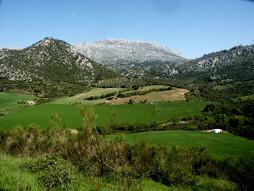Posted 27 June 2011

The landscape of the Alta Cadena, one of the karst aquifers studied, showing the various potential sources of dissolved organic matter.
Measuring the fluorescence of organic matter dissolved in groundwater can provide new insight into how surface water infiltrates into aquifers, and the quality of the groundwater.
Matías Mudarra and B. Andreo of Universidad de Málaga, along with CWI core team member Andy Baker, have recently published results of one of the largest ever studies of natural organic matter fluorescence in groundwater springs.
The work involved analysis of fluorescent organic matter in nineteen springs in three karst aquifer in southern Spain was combined with inorganic water chemistry analyses to understand the infiltration processes and hydrogeological functioning of the aquifers.
Additionally, the research showed that fluorescence analysis would be useful in the assessment of contaminant vulnerability.
As surface water travels into groundwater systems, it will typically infiltrate through the soil. Water-soluble organic matter present in the soil can be transported into the groundwater by this this infiltration process.
It has long been known that much of this dissolved natural organic matter is fluorescent. That is, if it is illuminated with a high energy light source, some of this energy will be absorbed and then re-emitted at a lower energy as fluorescence.
In the case of natural organic matter, the absorption and fluorescence all occurs in the ultra-violet light spectrum, so we can't see it. But routine lab instruments can measure this fluorescence, detecting very low concentrations of organic matter with just very small volumes of water needed.
Dissolved organic matter in all aquatic systems, including groundwater, is not stable and can be degraded. Microbial degradation is particularly important, as the dissolved organic matter provides the energy needed for microbial communities.
In groundwater springs, the measurement of the amount and character of dissolved organic matter using fluorescence can provide unique information about the hydrogeological functioning of the aquifer.
The paper 'Characterisation of dissolved organic matter in karst spring waters using intrinsic fluorescence: relationship with infiltration processes' by Mudarra, Andreo and Baker, is published in the journal Science of the Total Environment at doi:10.1016/j.scitotenv.2011.05.026. Personal copies are available on request from Andy Baker.
The paper was written while Matías Mudarra was a visiting researcher at CWI in 2010.

Professor Andy Baker features in American Water Resources Association ‘Water Resources Impact’, September 2020 edition.

The Connected Waters Initiative (CWI) is pleased to welcome Taylor Coyne to its network as a postgraduate researcher. If you’re engaged in research at a postgraduate level, and you’re interested in joining the CWI network, get in touch! The CWI network includes multidisciplinary researchers across the Schools of Engineering, Sciences, Humanities and Languages and Law.

The Grand Challenge on Rapid Urbanisation will establish Think Deep Australia, led by Dr Marilu Melo Zurita, to explore how we can use our urban underground spaces for community benefit.

On the 21 August 2020, CWI researchers made a submission to the National Water Reform Inquiry, identifying priority areas and making a number of recommendations as to how to achieve a sustainable groundwater future for Australia.

Results published from a research project between the Land Development Department (LDD) Thailand and UNSW has demonstrated how 2-dimensional mapping can be used to understand soil salinity adjacent to a earthen canal in north east Thailand (Khongnawang et al. 2020).